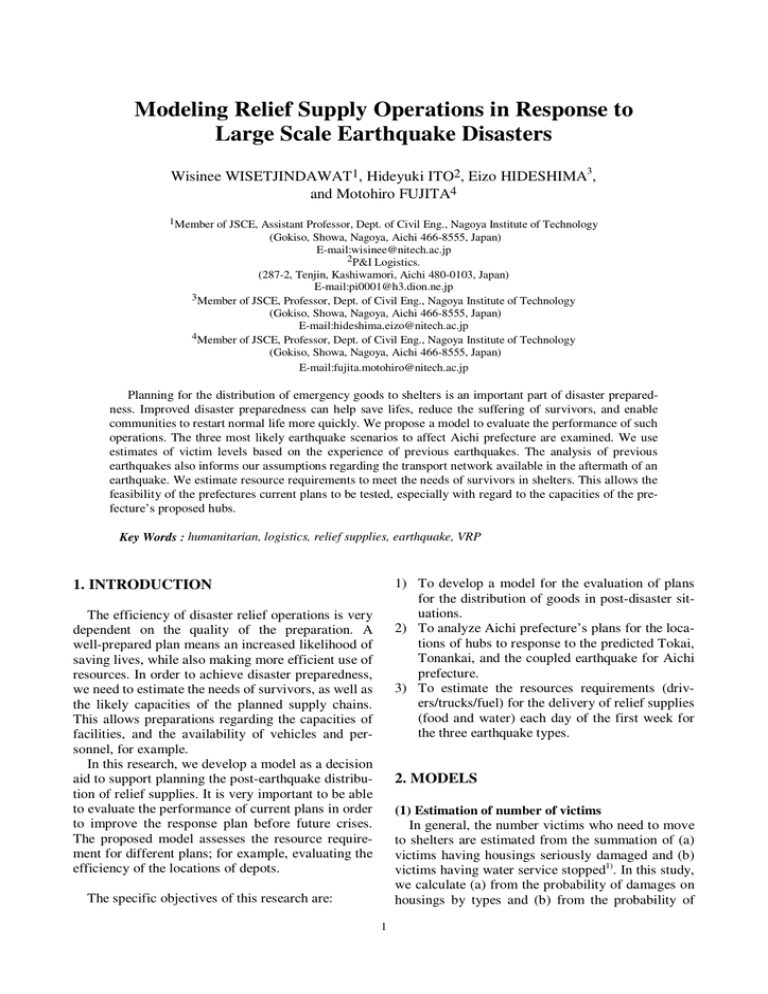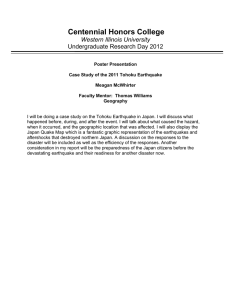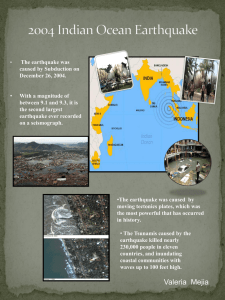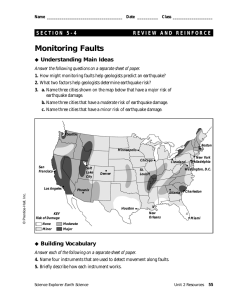Modeling Relief Supply Operations in Response to Large Scale Earthquake Disasters
advertisement

Modeling Relief Supply Operations in Response to Large Scale Earthquake Disasters Wisinee WISETJINDAWAT1, Hideyuki ITO2, Eizo HIDESHIMA3, and Motohiro FUJITA4 1Member of JSCE, Assistant Professor, Dept. of Civil Eng., Nagoya Institute of Technology (Gokiso, Showa, Nagoya, Aichi 466-8555, Japan) E-mail:wisinee@nitech.ac.jp 2P&I Logistics. (287-2, Tenjin, Kashiwamori, Aichi 480-0103, Japan) E-mail:pi0001@h3.dion.ne.jp 3Member of JSCE, Professor, Dept. of Civil Eng., Nagoya Institute of Technology (Gokiso, Showa, Nagoya, Aichi 466-8555, Japan) E-mail:hideshima.eizo@nitech.ac.jp 4Member of JSCE, Professor, Dept. of Civil Eng., Nagoya Institute of Technology (Gokiso, Showa, Nagoya, Aichi 466-8555, Japan) E-mail:fujita.motohiro@nitech.ac.jp Planning for the distribution of emergency goods to shelters is an important part of disaster preparedness. Improved disaster preparedness can help save lifes, reduce the suffering of survivors, and enable communities to restart normal life more quickly. We propose a model to evaluate the performance of such operations. The three most likely earthquake scenarios to affect Aichi prefecture are examined. We use estimates of victim levels based on the experience of previous earthquakes. The analysis of previous earthquakes also informs our assumptions regarding the transport network available in the aftermath of an earthquake. We estimate resource requirements to meet the needs of survivors in shelters. This allows the feasibility of the prefectures current plans to be tested, especially with regard to the capacities of the prefecture’s proposed hubs. Key Words : humanitarian, logistics, relief supplies, earthquake, VRP 1) To develop a model for the evaluation of plans for the distribution of goods in post-disaster situations. 2) To analyze Aichi prefecture’s plans for the locations of hubs to response to the predicted Tokai, Tonankai, and the coupled earthquake for Aichi prefecture. 3) To estimate the resources requirements (drivers/trucks/fuel) for the delivery of relief supplies (food and water) each day of the first week for the three earthquake types. 1. INTRODUCTION The efficiency of disaster relief operations is very dependent on the quality of the preparation. A well-prepared plan means an increased likelihood of saving lives, while also making more efficient use of resources. In order to achieve disaster preparedness, we need to estimate the needs of survivors, as well as the likely capacities of the planned supply chains. This allows preparations regarding the capacities of facilities, and the availability of vehicles and personnel, for example. In this research, we develop a model as a decision aid to support planning the post-earthquake distribution of relief supplies. It is very important to be able to evaluate the performance of current plans in order to improve the response plan before future crises. The proposed model assesses the resource requirement for different plans; for example, evaluating the efficiency of the locations of depots. 2. MODELS (1) Estimation of number of victims In general, the number victims who need to move to shelters are estimated from the summation of (a) victims having housings seriously damaged and (b) victims having water service stopped1). In this study, we calculate (a) from the probability of damages on housings by types and (b) from the probability of The specific objectives of this research are: 1 damages on lifeline infrastructures by types. The damage to housing is estimated using the distribution of percentage of damages on wood and non-wood housings on various seismic intensities provided by the previous research2). For the lifelines, there is a statistic model developed by Nojima and Sugito3) that estimates the level of damage, by seismic intensity level, on each type of infrastructures including electricity, water, and gas. The model was based on the experience of the Great Hanshin Awaji Earthquake in 1995. The model is a binary logit model estimating the probability that an earthquake with a given intensity will disrupt each lifeline utility. The model for each type of lifeline infrastructure is given below: For electricity, [ ..∙] P = [ ..∙] For water, [. .∙] P = [. .∙] where, vehicle routing simulation provides a sequence for deliveries to stockyards, which minimizes the total response time with constraints on the maximum carrying capacities of trucks and on the maximum working hours of drivers. 9 7 7 Minimize ∑5 ∑18 ∑28 c12 x12,56 (3) 7 ∑18 x12,56 = 1 Subject to ∑728 x12,56 = 1 w5 (x) ≤ wt 9< s5 (x) ≤ s9< t 5 (x) ≤ tt 9< 1, ifiimmediately x12,56 ∈ > preceedsj F 0, otherwise where, travel time between i and j [hours] c12 = depot k = k (1a) (1b) number of receivers w5 (x) = number of drivers [persons] = total load on vehicle of driver l [kg] wt 9< s5 (x) Nojima and Sugito3) also proposed a statistical model to estimate the expected duration of disruptions by each type of lifeline infrastructure. Their model is as follows: For water[days](5.0 ≤ I ≤ 7.0), μ(I) = 228.93 − 89.82I + 9.04I = m I = JMA seismic intensity For electricity[hours](5.2 ≤ I ≤ 6.8), μ(I) = 1067.96 − 409I + 39.47I n s9< t 5 (x) tt 9< (2a) = = = = = maximum carrying weight of a truck [kg] total volume for loading goods in truck used by driver l [pallets] maximum space of a truck [pallets] total travel time plus loading and unloading time of driver l [hours] maximum working hours of a driver [hours] 4. ANALYSIS OF SCENARIOS (2b) The prefecture reserves expressways and important trunk roads for operations during emergency. These roads are called the priority roads. We assume that this network of first priority roads can be used for delivery goods. On June 25, 2012, the authors conducted a questionnaire survey among freight forwarders in Sendai who distributed goods during the aftermath of the Great East Japan earthquake. From the survey, information on 79 separate delivery tours, performed by 21 different drivers, were obtained. Based on the survey results, the average driving speed of trucks during emergency was 42.3 kph on expressway and 16.0 kph on normal roads. These values are used in this calculation. In this study, we assume using 4-ton trucks (capacity of 3,500 kg. or 8 pallets) for the operation in order to ensure their accessibilities to all roads. As we consider the total response time, therefore, time where, I = JMA seismic intensity (2) Estimation of demands at each shelter This study analyses scenarios of the operations to provide “food and water” for the victims each day during the first week after the disaster. The demands of goods by municipality can be determined from the previously calculated number of victims by setting the requirement to provide food and water to each victim for 3 meals a day (for each person, 2 breads + 2 rice balls + 3 bottles of 500ml water bottles). 3. VEHICLE ROUTING MODEL (VRP) This problem is viewed as a multi-commodity vehicle routing problem. As the operation time is crucial for disaster relief, the objective function is set to be the optimization of total response time. The 2 required for handling goods (loading or unloading) at each facility are included. Based on the survey, the operations during the Great East Japan earthquake in Sendai require approximately 70 minutes for loading or unloading of goods of a full 4-ton truck manually at a non-warehouse facility; while, in general, it takes 20 minutes for the same works at a warehouse with forklifts. The maximum working hours of each driver is set to 6 hours in this case. With the assumptions above, three scenarios of earthquake disasters were analyzed in this study. They are: erations for the Tonankai earthquake, including Odaka park, Okazaki central park, Nagoya airport, and Ichinomiya sport center4) as shown in Fig.2. The cities are assigned to each depot based on their locations to the depots. The clusters are as depicted in the figure. Similarly, Group F is excluded due to requirement for special treatment. For depots, including parks and sport centers are considered as a non-warehouse facility; while at Nagoya airport, it is possible to operate by forklifts, therefore we considered this place as a warehouse facility. (3) Coupled earthquake The coupled earthquake has an expected magnitude of 8.3 (Mw); the intensity in Aichi ranges from 4.9 to 6.0 JMA3). The locations of depots and their clusters are as same as ones for the Tonankai earthquake as depicted in Fig.2. The handling times are set similarly to the case for the Tonankai earthquake. (1) Tokai earthquake The Tokai earthquake has an expected magnitude of 8.0 (Mw); the intensity in Aichi ranges from 4.7 to 5.6 JMA3). Based on the Aichi’s disaster response plan, the prefecture prepares three places as depots for supplying relief goods in response to the Tokai earthquake, including Odaka park, Okazaki central park, and Toyohashi sport center4). The locations are as shown in Fig. 1. For this earthquake, the area in Group A is affected less than in Groups D, E, and F. Therefore, Group A is clustered to cover the wider area comparing with the others. We have tested several clusters and finally these clusters required the least total resources required for the overall operation. Group F is excluded in this study because of high possibility of inaccessibility to these cities due to road disruptions. It is suggested to treat this group separately such as to delivery by helicopters. Fig. 2 Depots and clusters for Tonankai or Coupled earthquake 5. RESULTS The multi-commodity VRP model as depicted in Equation (3) is solved for each group and for each case of damages by the three types of earthquakes using Genetic Algorithm. The results of resource requirements including total number of drivers, trucks, and fuel required for the deliveries are presented in Figures 3, 4, 5, for Tokai earthquake, Tonankai earthquake, and the coupled earthquake respectively. During emergency, the operations are performed 24 hours a day. With the assumption of maximum 6-hours operation each day of each driver, therefore, in each day a truck can be used for 4 times. From this assumption, the total number of required trucks can Fig. 1 Depots and clusters for Tokai earthquake (2) Tonankai earthquake The Tonankai earthquake has an expected magnitude of 8.2 (Mw); the intensity in Aichi ranges from 4.9 to 6.0 JMA3). Based on the Aichi’s plan, the prefecture decides four places as depots for the op3 be calculated. The model also output the driving distance of each driver. Thus, the expected level of fuel consumption in each day can be estimated based on the driving distance of each driver. Even though the depot in Group A has to deal with the wider area comparing with the remaining groups, however, as the damages in this area is rather less than the other groups, therefore the resources requirements for the operations is not very different from those for another group. timate the days required for the services to be recovered. The results show that, from day 7, the lifeline utilities in some areas in Groups A and D are predicted to be recovered, resulting in significantly decreases in demands and hence reduced resources for these groups. On the other hand, Group E is heavier affected by the earthquake; thus victims in this group need to stay longer at the shelters and thus require longer supports. (a) Total number of drivers required by each group (a) Total number of drivers required by each group (b) Total number of trucks required by each group (b) Total number of trucks required by each group (c) Total fuel required by each group Fig. 4 Resources requirements for Tonankai EQ. (c) Total fuel required by each group Fig. 3 Resources requirements for Tokai EQ. Figure 4 depicts the results of resources required for the Tonankai earthquake’s operation. This earthquake is predicted to have larger impacts on Aichi prefecture more than by the Tokai earthquake. Therefore, it is reasonable that the prefecture increases the number of depots to 4 depots in response to this earthquake. However, considering the resources requirement at each depot, Group D requires In order to capture the variation of demands in each day, we assume that victims who seek shelters because of disrupted electricity and water services will be able to leave the shelters after the utilities recovered. Equations (2a) and (2b) were used to es4 the largest numbers of drivers, trucks, and fuel for the operations because of the largest impacts by the earthquake in this area. The depot of Group D has to deal with larger numbers of deliveries, which possibly causes congestion or delays in the operations. Therefore, it is suggested to increase number of depots for this group, for example, to use Toyohashi sport center as another depot for Group D to reduce workloads in this group. In addition, the depots reserved by the prefecture are mostly parks and sport centers. Handling times at these facilities take relatively longer times comparing with time required for the same works at a warehouse with logistics equipments. Definitely, relief supply operations performed by logistics specialists with proper equipments and facilities will increase the operation efficiency and thus requires less amount of resources, such as a driver can double the tours from previously can only deliver one time a day. (a) Total number of drivers required by each group 6. CONCLUSION We have presented a model, which analyses the delivery of relief supplies. The model was used to evaluate current plans in response to three possible earthquake scenarios for Aichi prefecture: Tokai, Tonankai, and a coupled earthquake. The model calculates resource requirements, which are important for planning disaster relief efforts. It is better have reliable estimates of resource requirements in order to avoid the shortages which followed previous earthquakes. Furthermore, these resource requirements can be used to check the capacity of facilities in order to ensure a smooth operation. The model was developed using a deterministic method, it is suggested to incorporate into the model the possibility of disruptions to the road network or other facilities. These remain for the future improvement. Simulation models of relief efforts can help planners to better estimate the resources required, the optimal placements of hubs and stockyards, and how to adapt to disruptions in these facilities or the transport network. (b) Total number of trucks required by each group (c) Total fuel required by each group Fig. 5 Resources requirements for Coupled EQ. Figure 5 demonstrates the resource requirements in the case that Tokai and Tonankai earthquakes strike the region at the same time (the coupled earthquake). This region impacted by this earthquake in the similar pattern to one by the Tonankai earthquake but with the higher intensity. Therefore, the prefecture should be prepared for this possibility by increasing the resources by approximately 4-5 percent from the resources required to response to the Tonankai earthquake alone. In addition, the operation for the coupled earthquake will need almost 2 times the resources required to response to only the Tokai earthquake. Similarly to the case of Tonankai earthquake, Group D is affected the heaviest and thus requires supports in larger amounts and for longer durations. REFERENCES 1) 2) 3) 4) Gunma Prefecture: Analysis of disaster victims, Report, 2012. (Japanese). Kyoto Disaster Prevention Office: Technique for estimation of damages by an earthquake. Report, December, 2005. (Japanese). Nojima, N. and Sugito, M.: Probabilistic assessment model for post-earthquake serviceability of utility lifelines and its practical application. Proceeding of ICOSSAR: Safety and reliability of engineering systems and structures, pp. 279-286, 2005. Aichi Emergency Response Division: Aichi’s plan for disaster relief supplies, Presentation, 2009. (Japanese). (Received August 3, 2012) 5







